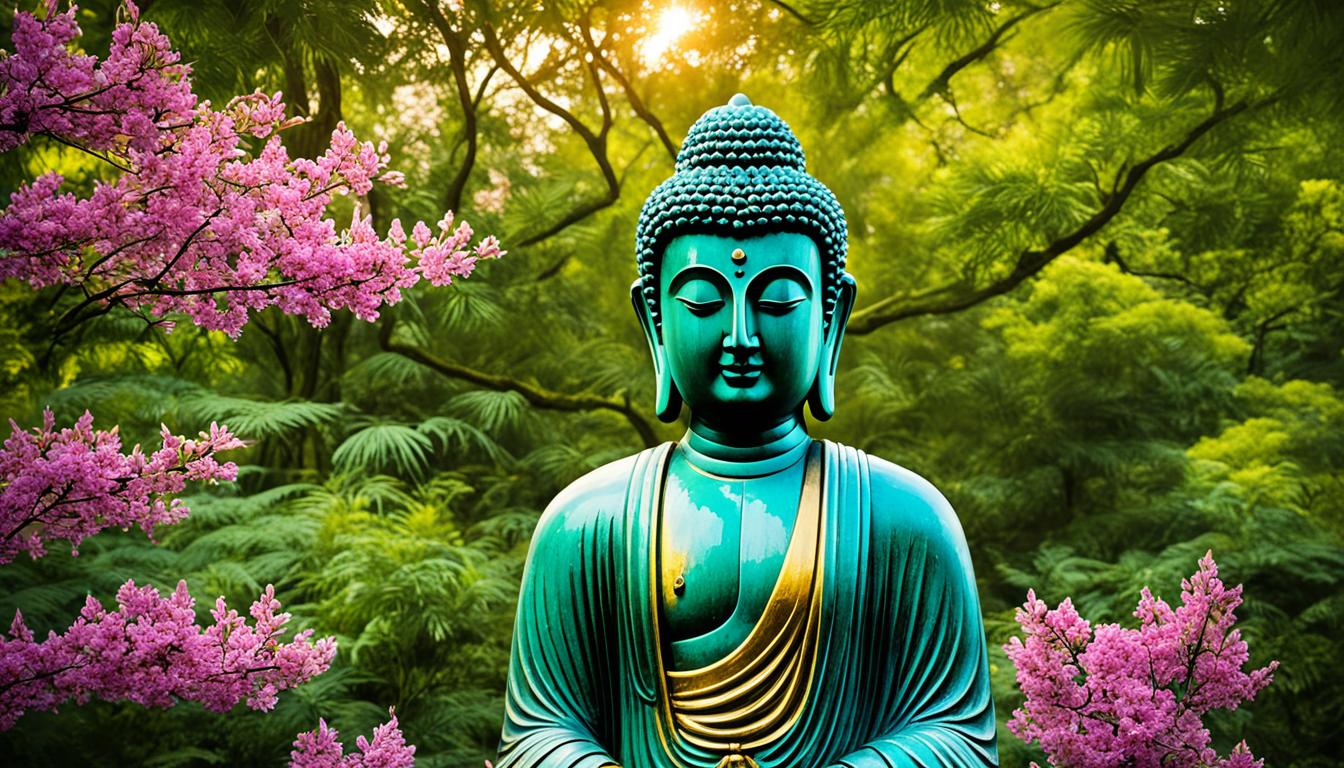“Happiness does not depend on what you have or who you are. It solely relies on what you think.” – Buddha
Welcome to a journey of enlightenment and self-discovery. Buddhism, founded over 2,500 years ago by Siddhartha Gautama, offers profound insights into the nature of existence and the path to inner peace. As one of the major world religions, Buddhism is practiced by millions of people worldwide, guiding them towards a deeper understanding of themselves and the world around them.
At the core of Buddhism are its fundamental beliefs, which provide a framework for leading a meaningful and fulfilling life. These beliefs revolve around the concepts of suffering, enlightenment, and ethical living. Buddhism is not just a religion but a unique philosophy that encourages individuals to take responsibility for their own happiness and well-being.
Throughout this article, we will delve into the main beliefs of Buddhism, the life of its founder Siddhartha Gautama, the core teachings encapsulated in the Four Noble Truths and the Noble Eightfold Path, the different types of Buddhism, the practice of meditation, and its influence around the world. Through exploring these aspects, you will gain a profound understanding of the transformative power of Buddhism and its impact on personal and societal harmony.
Key Takeaways:
- The main beliefs of Buddhism revolve around suffering, enlightenment, and ethical living.
- Buddhism teaches that happiness is not dependent on external circumstances but on the quality of one’s thoughts and intentions.
- The Four Noble Truths and the Noble Eightfold Path are the core teachings of Buddhism.
- There are different types of Buddhism, including Theravada, Mahayana, Tibetan, Zen, and Nirvana Buddhism.
- Meditation is a key practice in Buddhism, helping individuals cultivate mindfulness and achieve inner peace.
The Founder of Buddhism
Have you ever wondered about the origins of Buddhism? It all began with a remarkable individual named Siddhartha Gautama, more commonly known as the Buddha. Born into a wealthy family in present-day Nepal, Siddhartha led a life of privilege and opulence as a prince. However, his path took a transformative turn when he witnessed the suffering and pain that existed beyond the palace walls.
In a pursuit for answers, Siddhartha renounced his material wealth and embarked on a profound spiritual journey. For years, he explored various religious traditions and sought guidance from prominent teachers. Yet, it was through his own unwavering commitment and perseverance that Siddhartha finally achieved enlightenment under a Bodhi tree.
From that moment on, Siddhartha became the Buddha, which translates to “the awakened one.” He devoted the rest of his life to sharing his profound wisdom and teachings with others. The Buddha’s primary goal was to guide people on the path to enlightenment and the end of suffering.
The life of the Buddha serves as an inspirational reminder that personal transformation and spiritual awakening are within reach for all of us. His teachings continue to resonate today, offering guidance and a profound understanding of the human experience.
Key Teachings of the Buddha
The Buddha’s teachings revolve around the pursuit of enlightenment, the alleviation of suffering, and the cultivation of compassion. Throughout his lifetime, he emphasized that all individuals have the potential to attain profound insight and inner peace.
| Noble Truths | Noble Eightfold Path |
|---|---|
|
|
The Buddha’s teachings provide a comprehensive framework for personal growth and spiritual development. By practicing morality, meditation, and wisdom, individuals can cultivate a deep sense of peace, compassion, and understanding.
Continue reading to explore the core beliefs of Buddhism and the various types of Buddhism that have emerged over time.
Core Beliefs of Buddhism
In Buddhism, the core beliefs are centered around understanding the nature of suffering and the path towards alleviating it. These beliefs are encapsulated in the Four Noble Truths and the Noble Eightfold Path.
Four Noble Truths
- The truth of suffering (Dukkha): Life is inherently unsatisfactory and filled with suffering.
- The truth of the origin of suffering (Samudaya): Suffering arises from craving and clinging.
- The truth of the cessation of suffering (Nirodha): Suffering can be overcome by eliminating craving and attachment.
- The truth of the path to the cessation of suffering (Magga): Following the Noble Eightfold Path leads to the cessation of suffering.
The Four Noble Truths provide a framework for understanding and addressing suffering in a practical and profound way.
Noble Eightfold Path
- Right understanding: Developing a clear understanding of the Four Noble Truths and the nature of reality.
- Right thought: Cultivating thoughts of renunciation, non-harm, and kindness.
- Right speech: Speaking truthfully, kindly, and constructively.
- Right action: Acting in ways that align with the principles of non-harm and compassion.
- Right livelihood: Engaging in work that is ethical and does not cause harm.
- Right effort: Making a consistent effort to cultivate wholesome qualities and eliminate unwholesome ones.
- Right mindfulness: Cultivating mindfulness and awareness in all aspects of life.
- Right concentration: Cultivating focus and concentration through meditation.
The Noble Eightfold Path provides guidelines for ethical conduct, mental discipline, and the development of wisdom. It serves as a comprehensive roadmap towards the cessation of suffering and the attainment of enlightenment.
Buddhist Precepts
- Not harming living beings.
- Not taking what is not given.
- Leading a decent life.
- Not speaking unkindly.
- Abstaining from drugs and alcohol.
These precepts form the foundation of moral conduct in Buddhism. They serve as guidelines for daily life, promoting compassion, kindness, and ethical behavior.
Buddhist Scriptures
Buddhist scriptures play a significant role in the religion as a source of guidance and inspiration. The Tipitaka, also known as the Pali Canon, is the oldest and most authoritative collection of Buddhist scriptures. It is composed of three sections: the Vinaya Pitaka (rules for monastic discipline), the Sutta Pitaka (discourses of the Buddha), and the Abhidhamma Pitaka (philosophical analysis). In addition to the Tipitaka, various sutras and teachings attributed to the Buddha are revered and studied by Buddhists worldwide.

Types of Buddhism
Buddhism has evolved into different types over time. The three main types are Theravada Buddhism, Mahayana Buddhism, and Tibetan Buddhism. Each type has its own unique interpretations of Buddha’s teachings and practices.
1. Theravada Buddhism
Theravada Buddhism is prevalent in countries such as Thailand, Sri Lanka, Cambodia, Laos, and Burma. It is often referred to as the “Doctrine of the Elders” and emphasizes the original teachings of the Buddha. Theravada Buddhists strive to achieve enlightenment through meditation, moral behavior, and the observance of Buddhist precepts.
2. Mahayana Buddhism
Mahayana Buddhism is widely practiced in countries like China, Japan, Taiwan, Korea, Singapore, and Vietnam. It is known as the “Great Vehicle” and places strong emphasis on compassion and the ideal of the bodhisattva, a being dedicated to attaining enlightenment for the benefit of all sentient beings. Zen Buddhism, a form of Mahayana Buddhism, emphasizes simplicity and meditation as a means to achieve enlightenment.
3. Tibetan Buddhism
Tibetan Buddhism is prevalent in Tibet, Nepal, Mongolia, Bhutan, and parts of Russia and northern India. It incorporates elements of both Theravada and Mahayana Buddhism but also includes unique practices and rituals. Tibetan Buddhists believe in the Dalai Lama as the spiritual leader and focus on achieving enlightenment through meditation, visualization, and the practice of compassion.
4. Nirvana Buddhism
Nirvana Buddhism is closely related to Theravada Buddhism but places specific emphasis on achieving a state of pure enlightenment known as nirvana. It focuses on the Four Noble Truths and the Noble Eightfold Path as means to attain liberation from suffering. Nirvana Buddhism is often practiced in conjunction with Theravada Buddhism and can be found in countries where Theravada Buddhism is prevalent.

| Type of Buddhism | Main Regions | Key Characteristics |
|---|---|---|
| Theravada Buddhism | Thailand, Sri Lanka, Cambodia, Laos, Burma | Emphasizes original teachings of Buddha, meditation, moral behavior |
| Mahayana Buddhism | China, Japan, Taiwan, Korea, Singapore, Vietnam | Focuses on compassion, bodhisattva ideal, simplicity, and meditation |
| Tibetan Buddhism | Tibet, Nepal, Mongolia, Bhutan, parts of Russia and northern India | Incorporates Theravada and Mahayana elements, focuses on meditation, visualization, and compassion |
| Nirvana Buddhism | Prevalent in Theravada Buddhist countries | Specific emphasis on achieving a state of pure enlightenment, follows the Four Noble Truths and the Noble Eightfold Path |
The Practice of Buddhism
Meditation plays a significant role in Buddhism, guiding practitioners on their path to enlightenment and inner peace. By engaging in meditation, you can cultivate a focused and tranquil mind. There are several methods of meditation in Buddhism, each offering their own unique benefits.
Sitting Meditation: This is one of the most common forms of meditation in Buddhism. It involves finding a quiet and comfortable place to sit, focusing on your breath or a chosen object, and observing your thoughts and sensations without judgment.
Martial Arts: Buddhists also practice meditation through martial arts, such as tai chi or qigong. These physical movements are performed with mindful awareness, promoting both physical and mental well-being.
Contemplation: Contemplative practices, such as reflecting on riddles or reading and contemplating Buddhist texts and poems, help deepen understanding and insight into the nature of reality.
Using Mandalas: Mandalas are intricate geometric designs used for focusing the mind and facilitating meditation. By gazing at a mandala, you can enter a state of deep concentration and experience a sense of unity and peace.
Mindfulness of Breath: Another form of meditation involves simply bringing your attention to your breath and being fully present in the moment. This practice cultivates mindfulness, allowing you to observe your thoughts and emotions without getting caught up in them.
Buddhist rituals and practices encompass a wide range of traditions, varying according to different Buddhist sects and cultural backgrounds. These rituals often involve chanting, offering prayers and incense, bowing, and participating in ceremonies. They serve as a way to purify the mind, express gratitude, and cultivate compassion.
Mindfulness is highly valued in Buddhism as it encourages being fully present and aware of one’s thoughts, feelings, and actions in the current moment. It allows you to develop clarity, wisdom, and compassion in your daily life.

Buddhism Around the World
Buddhism, originating in South Asia, has spread its teachings and principles to various parts of the world. It has become a global faith embraced by millions of individuals seeking enlightenment and inner peace.
In its early years, Buddhism spread throughout Asia, influencing and molding the cultures and practices of different countries. The spread of Buddhism across Asia can be seen in countries like Sri Lanka, Myanmar, Thailand, Cambodia, Laos, China, Japan, Korea, and Vietnam. Each of these regions has adopted Buddhism and incorporated it into their own unique cultural and religious traditions.

One notable branch of Buddhism that gained prevalence in certain regions is Tibetan Buddhism. It emerged in Tibet, Nepal, Mongolia, Bhutan, and parts of Russia and northern India. Tibetan Buddhism has its distinct traditions and rituals, offering a rich tapestry of practice within the broader Buddhist framework.
Over time, Buddhism transcended geographical boundaries and expanded its reach to the Western world. Buddhism’s arrival in the West brought a fresh perspective on spirituality and mindfulness, attracting followers who sought alternative paths to personal growth and fulfillment.
Buddhism in the West has undergone adaptations to suit the needs and cultural context of Western societies. It has integrated with local philosophies and traditions, fostering a vibrant and diverse expression of Buddhist teachings. This integration has led to the emergence of various Buddhist traditions and practices in the Western world.
Buddhism, through its global journey, demonstrates its flexibility and capacity to adapt to different cultures and societies. It continues to evolve, resonate with people from various backgrounds, and provide guidance on the path to enlightenment and inner peace.
Conclusion
Buddhism offers profound insights into personal and societal harmony. By understanding and overcoming suffering, seeking enlightenment, and embracing ethical principles, Buddhism provides a path to inner peace and wisdom. The practice of mindfulness, meditation, and cultivating wisdom are central to the Buddhist teachings, enabling individuals to take responsibility for their own thoughts, actions, and well-being.
Buddhism has had a significant impact on individuals and communities worldwide, promoting compassion, mindfulness, and a deeper understanding of existence. By embracing the core beliefs of Buddhism, one can embark on a transformative spiritual journey and experience greater peace, happiness, and wisdom in life.
Key takeaways from Buddhism include the power of self-reflection, the acceptance of impermanence, the cultivation of compassion, and the pursuit of wisdom. By incorporating these teachings into our daily lives, we can cultivate personal growth, improve our relationships, and contribute to a more harmonious society.
FAQ
What are the main beliefs of Buddhism?
The main beliefs of Buddhism include the pursuit of enlightenment to attain inner peace and wisdom, the acknowledgment of Buddha as an enlightened being but not a god, the importance of morality, meditation, and wisdom on the path to enlightenment, the recognition of karma and reincarnation, and the worship in temples or homes.
Who is the founder of Buddhism?
The founder of Buddhism is Siddhartha Gautama, also known as the Buddha. He lived around the 5th century B.C. and renounced his wealth to seek enlightenment. After attaining enlightenment, he spent his life teaching others about the path to end suffering.
What are the core beliefs of Buddhism?
The core beliefs of Buddhism are encapsulated in the Four Noble Truths and the Noble Eightfold Path. The Four Noble Truths explain the nature of suffering, its causes, its cessation, and the path to end suffering. The Noble Eightfold Path consists of eight ideals for ethical conduct, mental discipline, and achieving wisdom.
What are the different types of Buddhism?
Buddhism has different types, including Theravada Buddhism, Mahayana Buddhism, Tibetan Buddhism, Zen Buddhism, and Nirvana Buddhism. Each type has slightly different interpretations of Buddha’s teachings and reveres certain texts.
What role does meditation play in Buddhism?
Meditation is a fundamental practice in Buddhism. It involves focusing the mind to achieve inner stillness and ultimately enlightenment. Buddhists meditate in various ways, such as sitting quietly, practicing martial arts, or being mindful of their breath.
How has Buddhism spread around the world?
Buddhism originated in South Asia and gradually spread to other Asian countries such as Sri Lanka, Thailand, China, Japan, and Vietnam. It also made its way to the Western world, where it has gained popularity and influence.
What is the impact of Buddhism on personal and societal harmony?
Buddhism offers insights into personal and societal harmony through its teachings and practices. By embracing Buddhism’s core beliefs, individuals can embark on a transformative spiritual journey and find greater peace, happiness, and wisdom in life. Buddhism promotes compassion, mindfulness, and a deeper understanding of the nature of existence.

